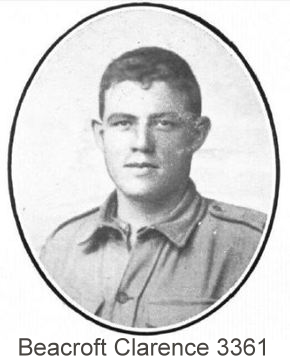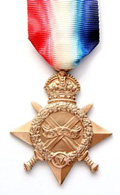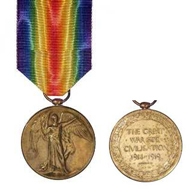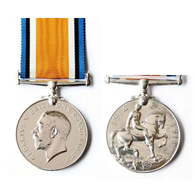BEACROFT Clarence
-

- 3361A
- Private
- 6th Field Company Engineers, 4th Division Signals Company
- Beerburrum Soldier Settlement
- Yes
- 1894
- Erith, Kent, England
- 30 August 1915
- HMAT A40 Ceramic
- 23 November 1915
- Melbourne
-
Family
Frank Beacroft, a steel dresser aged 26 years, married Alice Maud Albetter Lee on 5 May 1889 in Sheffield, England. George Frederick was born on 17 May 1890, Caroline in 1893 and Clarence in 1894 in Erith, Kent. All births were registered in Dartford, Kent.
In the Census of 1891, Frank and Alice Beacroft were living at 173 Bagley Road, Brightside, Sheffield with their first son George Frederick aged 10 months.
In the Census of 1901, Alice was "wife, head of house" at 11 Church Terrace, Erith with three children - Fred (10), Caroline (7) and Clarence (6).
In the Census of 1911, Clarence who declared his age as 18 years was a soldier with the Royal Horse Artillery in Woolwich, London where his rank was "driver". His widowed mother was living at 6 Raeburn Terrace, Lower Road, Erith, Kent as head of house.
Clarence emigrated to Australia aboard the Orient line ship "Oranto" which departed London on 24 April 1914 bound for Brisbane. He was 19 years of age and disclosed his occupation as labourer.
Enlistment
Clarence Beacroft enlisted at Rockhampton on 30 August 1915. He was by then 20 years and 10 months old. He was a solidly-built young man of 5 feet 5 ¾ inches in height weighing 154 pounds. He was of fair complexion, with grey eyes and light brown hair. His religion was Church of England. He declared his occupation as labourer and he disclosed his previous 205 days of military experience with the Royal Horse Artillery. He listed his mother Alice Beacroft at 111 Raeburn Terrace, Erith in Kent as his next of kin and allocated not less than two fifths of his pay to support his mother.
Clarence's service number was 3361 (an "A" was added later when it was discovered his number had been allocated to another). He was assigned to the 6th Field Company Engineers A.I.F. when his Attestation information was confirmed in Melbourne on 8 November 1915. On the other side of the world in Kent, his sister Caroline had just married Frederick Callum.
Service
On 23 November 1915, Sapper Beacroft and the 6th Field Engineers embarked from Melbourne on HMAT A40 "Ceramic". They were at full unit strength with twenty reinforcements. The soldiers disembarked at Port Said, Egypt at 8pm on 18th December and entrained to Kantara.
The company's activities moved progressively through Ferry Post, Hill 353 and Hogsback before returning to Ferry Post on 6 March. Their tasks covered most engineering duties: railway track laying and road forming and maintenance, trench construction around camps, individual weapons training, and company training. On 7 March, the company moved to Moascar and concentrated on training. Rumours suggested their time in Egypt was drawing to a close.
Going Separate Ways
On 17 March 1916, Sapper Beacroft reported to the 1st New Zealand Auxiliary Hospital at Ismailia with a contused wound to his leg. He was there when, next evening, his Company entrained for Alexandria where it boarded "City of Edinburgh" bound for France.
Sapper Beacroft transferred to the 3rd Australian General Hospital at Abbassia on 21 March. Six days later, he was moved to the 3rd Auxiliary Hospital at Heliopolis on the outskirts of Cairo. That same day, at the opposite end of the Mediterranean, the 6th Field Engineers disembarked at Marseilles. The company entrained for Abbeville, then marched to Warne.
On 3 April, Private Beacroft was discharged from Heliopolis to the Overseas Base at Giza for general duties.
On 28 May 1916, he embarked on the S.S. "Briton" at Alexandria bound for England where he was deployed to the Engineers Training Depot at Christchurch, Dorset.
On 19 October 1916, he left for France and reported at the Australian General Base Depot at Etaples on 21 October. On 18 November, he marched in at the No.2 A.H.T. Depot, Abbeville.
To Signals
On 31 May 1917, Private Beacroft was taken on strength of the 4th Division Signal Company from the Royal Engineers Signal Depot.
On 22 January 1918, he was granted furlough to the UK and re-joined his unit on 5 February. The work in signals was supporting a communications network between very fluid field positions and slightly less fluid base depots.
On 19 November 1918, he was granted UK leave; however, on 3 December, he was admitted to the 1st Auxiliary Hospital at Harefield suffering from rheumatism. On 7 December he was discharged to the No.2 Command Depot at Weymouth.
On 23 December, he went AWOL from Weymouth for four days. He was admonished by a senior officer and required to forfeit four days of pay. His restlessness after Armistice was heightened by separation from a new commitment in his life.
Repatriation to Australia
Clarence Beacroft married Alice Maria Herbert in the Dartford registration district, Kent in the last quarter of 1918. He was attended by his family who only four years earlier had bid him farewell for his emigration to Australia. They could not have expected his return, funded by the Empire, so soon after his departure.
He and his wife returned as a couple to Australia on the H.T."Zealandic". They left Tilbury docks, London on 3 July 1919 and they disembarked at Melbourne on 23 August. They then travelled by rail to Brisbane. Clarence was discharged from the A.I.F. on 19 October 1919. He was deemed medically unfit for future military service, although no specifics of his disability were recorded.
After the War
In December 1921, Clarence Beacroft wrote to Base Records from his home at the Beerburrum Soldiers Settlement enquiring as to the whereabouts of the service medals which were owing to him. Base Records replied that Victoria Barracks in Brisbane had been sent the medals in May 1920 and March 1921. They arrived in due course. He was issued the 1914/15 Star and the British War and Victory Medals.
On 7 August 1923, the "Brisbane Courier" reported that the monthly Court in Brisbane before the Land Commissioner had approved the granting of Perpetual Lease selection 437 at Beerwah to Clarence Beacroft. In the Electoral Roll of 1925, Clarence Beacroft was a farmer at Beerburrum.
By 1937, he had moved to the city and was a linesman living with his wife at Rose Avenue, Yeronga. That year, their daughter Gladys May passed the Junior Public Examination at the State Commercial High School and College and was offered employment in the Public Service.
In the 1943 Roll, Clarence was temporarily alone in Bowen. His occupation remained linesman until his death. In the same Roll, his wife Alice was living at Ellesmere Street, Yeronga with their daughter Gladys May who was a clerk-typist.
Their son Donald Frank Beacroft, an electrician, married Lorna Mary McMahon in Albert Street Methodist Church on 5 December 1953. They were to have four children Donald Christopher, Laura Elizabeth, Gregory John and Judy-Anne Lilliane.
Clarence Beacroft, ex-A.I.F., died on 5 January 1964 and was buried in Mt. Gravatt cemetery. His brother George survived him by five years and died in 1969 in Kent, England.
Alice, his widow, continued to live at 43 Ellesmere Street until at least 1980.
Donald Beacroft died in Canberra on 8 February 1991.
-
- Egypt
- Western Front
-

-

-

- Returned to Australia
- 23 August 1919
- 5 January 1964
- Brisbane, Queensland
- 70 years
- Mt. Gravatt Cemetery, Brisbane
-
National Australia Archives
Australian War Memorial
Trove digitised newspapers
Ancestry.com
- Grant Thorne
